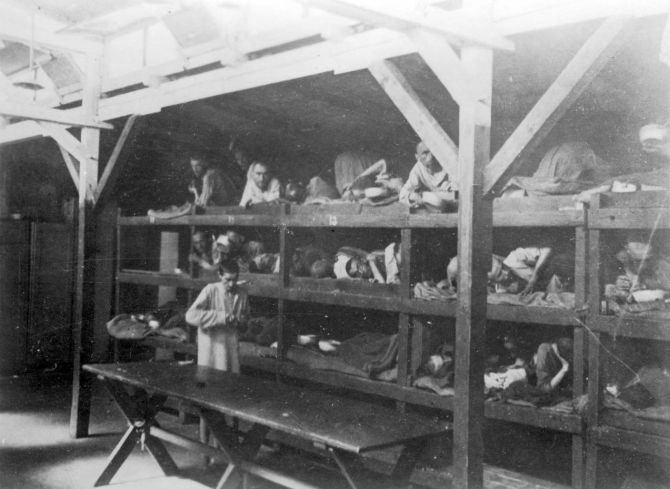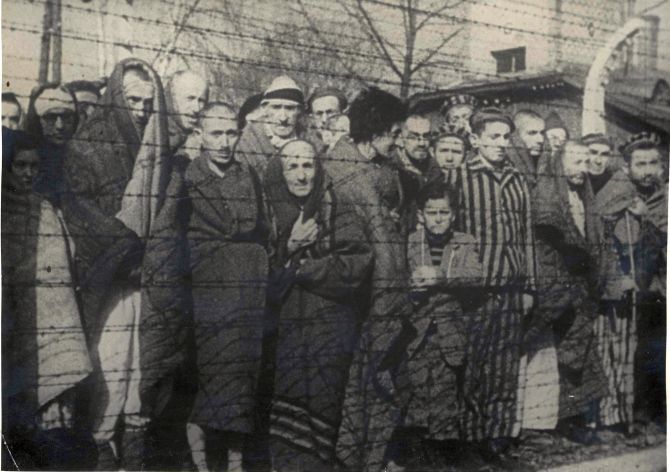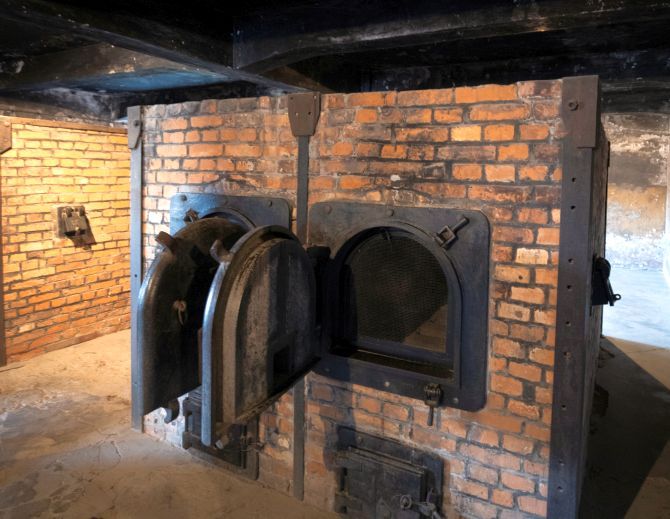'The response to savagery and mass injustice is never a persistent howl.'
'There will be, among the victims, those who choose to forget the scars, those who go on living, those who challenge the overall environment of sentimentality.'
'And the more effort you put into including these other voices, into assimilating these spoilsports, the more balanced your depiction of the tragedy in question will be,' observes Sreehari Nair.

The massive success of Vivek Agnihotri's The Kashmir Files, and the lecturing and finger wagging that followed the success, got me thinking. I wondered, 'In a time of genocide remembrance and victim glorification, what function does a spoilsport perform?' And it was my search for just such a spoilsport that led me to Yoram Sheftel.
Yoram Sheftel, the ostensible hero of the Netflix documentary, The Devil Next Door, was once -- and by many accounts, still is -- the most hated figure in Israel.
But why did this man, this always nattily dressed and always smiling man, with a beautiful, light voice, have to endure a period of intense public backlash, when he was heckled, was spat on, had acid thrown in his face?
Well, many might say Sheftel had it coming. His sin was that he had chosen to defend in court John Demjanjuk, a retired autoworker from Cleveland, USA, who was accused of being an operator of the gas chambers at the Treblinka Death Camp in Poland, where 8,50,000 Jews had perished during World War II.
A picture released by the KGB in the mid-1970s showed a young man, a guard at one of the SS death camps, who bore a striking resemblance to Demjanjuk. Based on the picture, a number of Holocaust survivors identified Demjanjuk as not just any ordinary SS guard, but the cruel guard they had nicknamed Ivan the Terrible, who was famous for torturing men, women, and children, just minutes before they were dispatched as part of the 'final solution' to chambers all ready to spurt Zyklon B.
Demjanjuk, of Ukrainian origin, known in his Cleveland neighbourhood as a responsible citizen, a loyal husband, and a loving father, claimed that it was a case of mistaken identity. But Jerusalem pressed charges of gross crimes against humanity, and the United States not wishing to take this ignominy upon itself extradited Demjanjuk in February of 1986.
What followed was one of the greatest trials of the last century, a trial that brought Israel to a standstill, as one Treblinka survivor after another, some scarcely able to stand, came to the witness box and bared their hearts. They sniffled, their voices cracked as they recounted the names of the relatives they had lost, they broke down time and again, and gathering all their strength they trained their parting gaze at bald, stocky Demjanjuk and declared: 'There he stands, the Devil responsible for most of our misfortunes!'
Yoram Sheftel, drumming his knuckles on the counsel table, would observe all of this with keen attention. He was, within his professional circle, viewed as someone with more flash than substance, someone who could turn contrarian just for the heck of it.
In The Devil Next Door, Sheftel confirms that all the popular opinions about him are indeed true. He giggles as he talks about his own mother who thought him worthless. We get a quote from someone who says that Sheftel cannot be trusted, and the person who makes this statement is revealed to be Sheftel's best friend.

This, however, happens to be just one side of the man. Because on watching the Netflix documentary, we are treated to a steady accumulation of shocking perspectives. Shocking, not for the graphic details we expect to encounter, but shocking to our good sense and to that side of ours that wants justice to be served... and now!
For instance, we come to realise that being so out of favour, and most importantly being aware of his situation, Sheftel (who swivels his neck like a barnyard rooster) had developed a tough eye, not to mention a sense of objectivity, both of which people tend to lose in an emotionally charged setting such as a Holocaust trial.
After being drafted into the case Sheftel influenced the sacking of Demjanjuk's American lawyer; helplessly watched his client being handed out the death penalty in 1988; made trips to Russia, and gathered as evidence KGB documents that conclusively proved that Demjanjuk could not have been Ivan the Terrible; and just as the trapdoor was about to be opened, got the death sentence overturned and secured the release of the ex-autoworker/war criminal in 1993.*
With talent and luck on his side, an ambitious writer may come up with a character as three-dimensional as Yoram Sheftel. Despite his clowning and his cheekiness, which at first might seem inappropriate to a sensitive case as the one he was handling, Sheftel comes off as the only person in that courtroom who understood the difference between 'Holocaust' and 'Holocaustomania', and understood that terrible miscarriages of justice can come about when people confuse the latter for the former.
So he sits today, in his check wool gabardine suit and his plush home adorned with paintings of Salvador Dali, recalling the case in the following terms: "To be honest, I was enjoying every second of it." He says this even as his effigies continue to go up in flames in many public squares across Israel.
As a contrast to the above segments of elation and protest, The Devil Next Doorgives us monastic shots of the judges who had handed Demjanjuk his death sentence, and the public prosecutor who had secured it for the Jews, some of whom had smooth skins that now seem infested with scales, and some of whom had alert eyelids that now droop, and in all of whose voices we can detect the same mood of helplessness.
My first acquaintance with John Demjanjuk had happened over a reading of Philip Roth's novel, Operation Shylock, which has a big section dedicated to the Demjanjuk case. The section is composed in the part playful, part meditative tone employed throughout the noveland Roth had, in point of fact, based it on firsthand experience. He had attended the trial for months on end, and confessed to have been riveted by it.
And who can blame him?
Purely as a documentary The Devil Next Door is up-and-down, and the stabs at aestheticisation by camera, as well as the forced air of solemnity that blows over big chunks, don't quite work. But the lumpy bits can be overlooked for actual footage from the trial, which make up more than three-fourth of the documentary, and which are nothing less than chilling -- chilling, albeit in a human way.
I won't be exaggerating if I say that you cannot look away for even a second when the courtroom clips are on. Not just the testimonies of the survivors, but all those Jewish noses swelling and twitching in the crowd, an informal gesture from the defense lawyer to his team, a passing deliberation between the judges, Irene Demjanjuk's beautiful greyish-blue eyes scanning her father for signs of meltdown -- every single frame of the trial strikes you as a significant guidepost of history. And that explains why a State-owned Israeli television channel had broadcasted the trial live, and why in the two year period over which it took place a visible drop was reported in the national productivity.
I was surprised to find the Demjanjuk trial not listed in Wikipedia among the trials of the century. While morally and psychologically more complex than the trial of Adolf Eichmann, or that of O J Simpson or Bill Clinton, the man at the centre of the Demjanjuk trial was a more interesting character than Eichmann and Simpson and Clinton put together.

Handcuffed as he walks down an El Al Israeli flight, his features remarkably preserved at 66, we see Demjanjuk turning to the authorities and asking for permission to kiss the holy hand. Loitering in his tiny prison cell in a vest and shorts, he shows a foreign correspondent the many fan mails he has received from all over the world.
Seated in the witness box, he listens to translations of the survivors' accounts with an interest bordering on mirth. He evidently hates no one, and even offers his hand to one of the survivors who shoos him away. At one point in the trial, without any coaxing whatsoever, he reveals a tattoo in his left armpit, a Nazi tattoo that leads to his eventual conviction.
We survey all this and it dawns on us: Animal or human, devil or saint, we are witnessing the public humiliation of a man who is slowly growing senile.
And this was part of the comedy of that case: That it was a passionate rencontre between an accused and his set of accusers, both of whom were trying to reclaim a turf of history, while fighting their personal battles with fading memory.
For senility was general among the survivors as well.
Their testimonies, we discover, are fraught with contradictions and inconsistencies. Many are shown to weep for their dead children, and then blurt out their names wrong.
Plus, there was the looming issue of sanctimony coming over the previously shamefaced.
The Holocaust witnesses, it becomes obvious to us, were people experiencing their first stint as heroes after forty good years of living in mortification.
Among the wartime documents presented by the defense is a letter written by one of the witnesses. In the letter, he boasts of having personally killed Ivan the Terrible, and which he confesses was an attempt to cover up his embarrassment about surviving a genocide that had consumed six million of his brethren.

By the time I was done watching The Devil Next Door, my mind was buzzing with scenes like the one mentioned above. Instead of being worked up into a state of anger or righteous fervour, I felt stimulated.
We are not hardwired to view genocides, people's revolutions, and riots, as acts of comedy. Yet, a real artist is one who understands that events of this nature, ones that cause dents in our collective consciousness, cannot help but turn into human comedies; because they are, both in the way they occur and in the way they are regurgitated, bound to be coloured by piety.
It's also true that the response to savagery and mass injustice is never a persistent howl. There will be, among the victims, those who choose to forget the scars, those who go on living, those who challenge the overall environment of sentimentality. And the more effort you put into including these other voices, into assimilating these spoilsports, the more balanced your depiction of the tragedy in question will be.
I recently happened to watch on YouTube a WildFilmsIndia presentation about the exodus.
In it, we meet an old Kashmiri Pandit who sets his own rhythms, and establishes the progression of his experiences. On being asked, "Why did you leave Kashmir and come to Jammu?" the old man replies, "My whole family is here; what would I have done staying back?" And then, you catch him snorting at the questioner in disgust.
Next, a young schoolteacher, who had migrated to Punjab, speaks to the camera with an easy dramatic force. She expresses confidence about her future and says, "I'll get by doing embroidery and sewing. Or perhaps, typing and shorthand. I may not know shorthand, but I'll learn it anyhow."
These un-coached words manage to bring the tragedy into clearer focus; and the grainy presentation itself, achieved without any prodding, has an urgency that a feature film trying to push buttons can never have.
As I see it, the finest re-enactments of human monstrosities are those that religiously reject the templates popularized by exploitation cinema. They affect you not by getting your prefabricated perspectives racing, but by giving you pause.

A sequence in The Devil Next Door perfectly illustrates this sensibility.
We watch Gustav Borax, a Treblinka survivor, narrating his story. The details of the story are so horrifying that even the judges are moved to tears.
At this point, Demjanjuk's American lawyer casually asks Borax how he happened to travel from Poland to Miami, Florida, where his deposition was taken by the Office of Special Investigations. Borax hesitates for about a minute before replying: "We went there by train."
The answer is enough to send the sanctimonious courtroom into a tizzy. Demjanjuk's lawyer is left too stunned to retaliate, and the judges call for an early recess.
*In 2011, John Demjanjuk was convicted of acting as an accessory to murder at Sobibor, a different extermination camp. He died in prison, at the age of 92.
Feature Presentation: Aslam Hunani/Rediff.com











 © 2025
© 2025